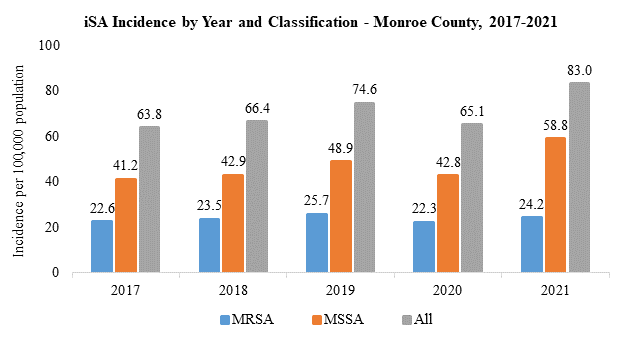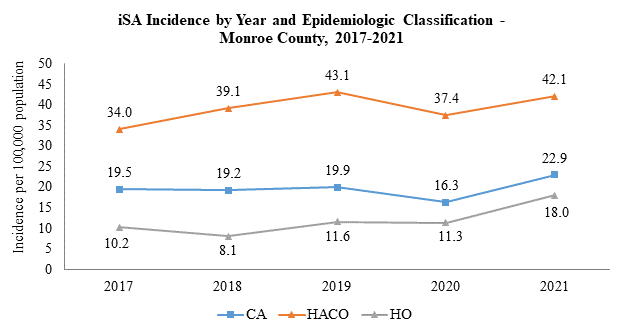Invasive Staphylococcus aureus Surveillance
Purpose
To perform active population-based surveillance for invasive Staphylococcus aureus (iSA) infections in Monroe County, New York.
Goals and Objectives
 Document the incidence and epidemiologic characteristics of invasive Methicillin-resistant S. aureus (MRSA) and Methicillin-sensitive S. aureus (MSSA) infections in diverse geographic areas in the United States and determine if the infection is Health Care-Associated (HA) or Community-Associated (CA).
Document the incidence and epidemiologic characteristics of invasive Methicillin-resistant S. aureus (MRSA) and Methicillin-sensitive S. aureus (MSSA) infections in diverse geographic areas in the United States and determine if the infection is Health Care-Associated (HA) or Community-Associated (CA).- Determine the molecular epidemiologic patterns and microbiologic characteristics of invasive MRSA.
Activities
Through partnership with local microbiology laboratories, weekly lists of potential iSA cases are received and reviewed. Data collected on confirmed cases includes demographics, patient outcomes, types of infections and co-morbidities.
Cases are classified as CA or HA based on risk factors, allowing for tracking of trends in iSA epidemiology over time. Select MRSA isolates are sent to the state public health lab and CDC to identify trends in MRSA strain type.
Since 2012, the incidence of Hospital-onset (HO) MRSA has decreased substantially, likely due to national infection prevention efforts. More robust prevention of MRSA in the hospitals has also likely caused a decrease in infections that develop in the community among individuals recently discharged from the hospital (HACO-MRSA). Meanwhile, Community-associated (CA) MRSA incidence has remained relatively stable.


The CDC features the latest infection tracking information for iSA here.
Publications
- Rha B, See I, Dunham L, Tracy M, Dumyati G, Cleveland T, Gellert A, et al. Vital Signs: Health Disparities in Hemodialysis-Associated Staphylococcus aureus Bloodstream Infections — United States, 2017–2020. MMWR Morb Mortal Wkly Rep. ePub: 6 February 2023. DOI: http://dx.doi.org/10.15585/mmwr.mm7206e1.
- Hartnett KP; Jackson KA; Felsen C; McDonald R; Bardossy AC; Gokhale RH; Kracalik I; Lucas T; McGovern O; Van Beneden CA; Mendoza M; Bohm M; Brooks JT; Asher AK; Magill SS; Fiore A; Blog D; Dufort EM; See I; Dumyati G. Bacterial and Fingal Infections in People Who Inject Drugs - Western NY, 2017. MMWR Morb Mortal Wkly Rep 2019;68:583–586.
- Kourtis AP; Hatfield K; Baggs J; Mu Y; See I; Epson E; Nadle J; Kainer MA; Dumyati G; Petit S; Ray SM; Emerging Infections Program MRSA author group; Ham D; Capers C; Ewing H; Coffin N; McDonald LC; Jernigan J; Cardo D. Vital Signs: Epidemiology and Recent Trends in Methicillin-Resistant and in Methicillin-Susceptible Staphylococcus aureus Bloodstream Infections - United States. MMWR Morb Mortal Wkly Rep. 2019 Mar 8;68(9):214-219.
- See I; Mu Y; Albrecht V; Karlsson M; Dumyati G; Hardy DJ; Koeck M; Lynfield R; Nadle J; Ray SM; Schaffner W; Kallen AJ. Trends in incidence of methicillin-resistant Staphylococcus aureus bloodstream infections differ by strain type and healthcare exposure, United States, 2005-2013. Clin Infect Dis. 2019; Epub 2019 Feb 25.
- Gualandi N, Mu Y, Bamberg WM, Dumyati G, Harrison LH, Lesher L, Nadle J, Petit S, Ray SM, Schaffner W, Townes J, McDonald M, See I. Racial Disparities in Invasive Methicillin-resistant Staphylococcus aureus Infections, 2005-2014. Clin Infect Dis. 2018 Sep 28;67(8):1175-1181.
- Grigg C, Palms D, Stone ND, Gualandi N, Bamberg W, Dumyati G, Harrison LH, Lynfield R, Nadle J, Petit S, Ray S, Schaffner W, Townes J, See I. Burden of Invasive Methicillin-Resistant Staphylococcus aureus Infections in Nursing Home Residents. J Am Geriatr Soc. 2018. Aug;66(8):1581-1586.
- Jackson KA, Bohm MK, Brooks JT, Asher A, Nadle J, Bamberg WM, Petit S, Ray SM, Harrison LH, Lynfield R, Dumyati G, Schaffner W, Townes JM, See I. Invasive Methicillin-Resistant Staphylococcus aureus Infections Among Persons Who Inject Drugs - Six Sites, 2005-2016. MMWR Morb. Mortal Wkly Rep. 2018 Jun 8;67(22):625-628.
- See I, Wesson P, Gualandi N, Dumyati G, Harrison LH, Lesher L, Nadle J, Petit S, Reisenauer C, Schaffner W, Tunali A, Mu Y, Ahern J. Socioeconomic Factors Explain Racial Disparities in Invasive Community-Associated Methicillin-Resistant Staphylococcus aureus Disease Rates. Clin Infect Dis. 2017;64(5):597-604.
- Epstein L, Mu Y, Belflower R, Scott J, Ray S, Dumyati G, Felsen C, Petit S, Yousey-Hindes K, Nadle J, Pasutti L, Lynfield R, Warnke L, Schaffner W, Leib K, Kallen AJ, Fridkin SK, Lessa FC. Risk Factors for Invasive Methicillin-Resistant Staphylococcus aureus Infection After Recent Discharge From an Acute-Care Hospitalization, 2011-2013. Clinical Infectious Diseases: 2016; 62:45-52.
- Iwamoto M, Mu Y, Lynfield R, Bulens SN, Nadle J, Aragon D, Petit S, Ray SM, Harrison LH, Dumyati G, Townes JM, MD, Schaffner W, Gorwitz RJ and Lessa FC. Trends in Invasive Methicillin-resistant Staphylococcus aureus Infections. Pediatrics. 2013;132(4): e817-24.
- Dantes R, Mu Y, Belflower R, Aragon D, Dumyati G, Harrison LH, Lessa FC, Lynfield R, Nadle J, Ray SM, Schaffner W, Townes J, and Fridkin S. National Burden of Invasive Methicillin-Resistant Staphylococcus aureus Infections, United States, 2011. JAMA Intern Med. 2013;173(21):1970-8.